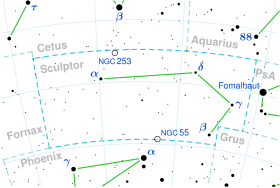Beta Sculptoris
| Observation data Epoch J2000 Equinox J2000 | |
|---|---|
| Constellation | Sculptor |
| Right ascension | 23h 32m 58.25898s[1] |
| Declination | −37° 49′ 05.7570″[1] |
| Apparent magnitude (V) | 4.37[2] |
| Characteristics | |
| Spectral type | B9.5IIIp(HgMnSi)[3] |
| U−B color index | −0.36[2] |
| B−V color index | −0.09[2] |
| Variable type | suspected |
| Astrometry | |
| Radial velocity (Rv) | +0.4±0.6[5] km/s |
| Proper motion ( | RA: +95.97[1] mas/yr Dec.: +38.29[1] mas/yr |
| Parallax ( | 18.74 ± 0.15 mas[1] |
| Distance | 174 ± 1 ly (53.4 ± 0.4 pc) |
| Absolute magnitude (MV) | 0.74[6] |
| Details | |
| Mass | 2.98[7] M☉ |
| Radius | 2.0[8] R☉ |
| Luminosity | 81[7] L☉ |
| Surface gravity (log g) | 4.28[8] cgs |
| Temperature | 12,110[7] K |
| Metallicity [Fe/H] | +0.15[6] dex |
| Rotation | 1.9311[9] d |
| Rotational velocity (v sin i) | 26[7] km/s |
| Other designations | |
| Database references | |
| SIMBAD | data |
Beta Sculptoris, Latinized from

This is a B-type giant star with a stellar classification of B9.5IIIp(HgMnSi).[3] It belongs to the class of chemically peculiar stars known as a Mercury-Manganese star,[13] showing overabundances of mercury, manganese, and silicon in its spectrum. It is a suspected
References
[edit]- ^ a b c d e Van Leeuwen, F. (2007). "Validation of the new Hipparcos reduction". Astronomy and Astrophysics. 474 (2): 653–664. arXiv:0708.1752. Bibcode:2007A&A...474..653V. doi:10.1051/0004-6361:20078357. S2CID 18759600. Vizier catalog entry
- ^ a b c d Ducati, J. R. (2002). "VizieR Online Data Catalog: Catalogue of Stellar Photometry in Johnson's 11-color system". CDS/ADC Collection of Electronic Catalogues. 2237. Bibcode:2002yCat.2237....0D.
- ^ a b Abt, Helmut A.; Morrell, Nidia I. (1995). "The Relation between Rotational Velocities and Spectral Peculiarities among A-Type Stars". Astrophysical Journal Supplement. 99: 135. Bibcode:1995ApJS...99..135A. doi:10.1086/192182.
- ^ a b Watson, C. L. (2006). "The International Variable Star Index (VSX)". The Society for Astronomical Sciences 25th Annual Symposium on Telescope Science. Held May 23–25. 25: 47. Bibcode:2006SASS...25...47W.
- ^ Gontcharov, G. A. (2006). "Pulkovo Compilation of Radial Velocities for 35 495 Hipparcos stars in a common system". Astronomy Letters. 32 (11): 759–771. arXiv:1606.08053. Bibcode:2006AstL...32..759G. doi:10.1134/S1063773706110065. S2CID 119231169.
- ^ a b Anderson, E.; Francis, Ch. (2012). "XHIP: An extended hipparcos compilation". Astronomy Letters. 38 (5): 331. arXiv:1108.4971. Bibcode:2012AstL...38..331A. doi:10.1134/S1063773712050015. S2CID 119257644. Vizier catalog entry
- ^ a b c d e f g Zorec, J.; Royer, F. (2012). "Rotational velocities of A-type stars". Astronomy & Astrophysics. 537: A120. arXiv:1201.2052. Bibcode:2012A&A...537A.120Z. doi:10.1051/0004-6361/201117691. S2CID 55586789. Vizier catalog entry
- ^ a b c Allende Prieto, C.; Lambert, D. L. (1999). "Fundamental parameters of nearby stars from the comparison with evolutionary calculations: Masses, radii and effective temperatures". Astronomy and Astrophysics. 352: 555–562. arXiv:astro-ph/9911002. Bibcode:1999A&A...352..555A. Vizier catalog entry
- ^ Barraza, L. F.; Gomes, R. L.; Messias, Y. S.; Leão, I. C.; Almeida, L. A.; Janot-Pacheco, E.; Brito, A. C.; Brito, F. A. C.; Santana, J. V.; Gonçalves, N. S.; Das Chagas, M. L.; Teixeira, M. A.; De Medeiros, J. R.; Canto Martins, B. L. (2022). "Rotation Signature of TESS B-type Stars. A Comprehensive Analysis". The Astrophysical Journal. 924 (2): 117. arXiv:2202.01022. Bibcode:2022ApJ...924..117B. doi:10.3847/1538-4357/ac3335. S2CID 246030494.
- ^ "bet Scl". SIMBAD. Centre de données astronomiques de Strasbourg. Retrieved 2017-11-28.
{{cite web}}: CS1 maint: postscript (link) - ^ Chini, R.; et al. (2012), "A spectroscopic survey on the multiplicity of high-mass stars", Monthly Notices of the Royal Astronomical Society, 424 (3): 1925, arXiv:1205.5238, Bibcode:2012MNRAS.424.1925C, doi:10.1111/j.1365-2966.2012.21317.x, S2CID 119120749.
- ^ Pedersen, May G.; Chowdhury, Sowgata; Johnston, Cole; Bowman, Dominic M.; Aerts, Conny; Handler, Gerald; De Cat, Peter; Neiner, Coralie; David-Uraz, Alexandre; Buzasi, Derek; Tkachenko, Andrew; Simón-Díaz, Sergio; Moravveji, Ehsan; Sikora, James; Mirouh, Giovanni M.; Lovekin, Catherine C.; Cantiello, Matteo; Daszyńska-Daszkiewicz, Jadwiga; Pigulski, Andrzej; Vanderspek, Roland K.; Ricker, George R. (February 2019). "Diverse Variability of O and B Stars Revealed from 2-minute Cadence Light Curves in Sectors 1 and 2 of the TESS Mission: Selection of an Asteroseismic Sample". The Astrophysical Journal Letters. 872 (1): L9. arXiv:1901.07576. Bibcode:2019ApJ...872L...9P. doi:10.3847/2041-8213/ab01e1. S2CID 118963697.
- ^ Makaganiuk, V.; et al. (January 2011), "The search for magnetic fields in mercury-manganese stars", Astronomy and Astrophysics, 525: A97, arXiv:1010.3931, Bibcode:2011A&A...525A..97M, doi:10.1051/0004-6361/201015666, S2CID 118860674.

